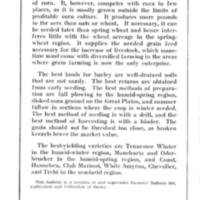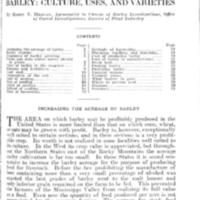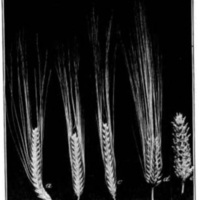Barley: Culture, Uses, and Varieties
Creator
Date
1925
Relation
Excerpt
BARLEY should be more widely grown in the Northern and Western States. It is an excellent grain feed for stock, being almost the equal of corn. It, however, competes with corn in few places, as it is mostly grown outside the limits of profitable corn culture. It produces more pounds to the acre than oats or wheat. If necessary, it can be seeded later than spring wheat and hence interferes little with the wheat acreage in the spring-wheat region. It supplies the needed grain feed necessary for the increase of livestock, which sometime must come with diversified farming in the areas where grain farming is now the only enterprise.
The best lands for barley are well-drained soils that are not sandy. The best returns are obtained from early seeding. The best methods of preparation are fall plowing in the humid-spring region, disked corn ground on the Great Plains, and summer fallow in sections where the crop is winter seeded. The best method of seeding is with a drill, and the best method of harvesting is with a binder. The grain should not be threshed too close, as broken kernels lower the market value.
The best-yielding varieties are Tennessee Winter in the humid-winter region, Manchuria and Oderbrucker in the humid-spring region, and Coast, Hannehen, Club Mariout, White Smyrna, Chevalier, and Trebi in the semiarid region.
The best lands for barley are well-drained soils that are not sandy. The best returns are obtained from early seeding. The best methods of preparation are fall plowing in the humid-spring region, disked corn ground on the Great Plains, and summer fallow in sections where the crop is winter seeded. The best method of seeding is with a drill, and the best method of harvesting is with a binder. The grain should not be threshed too close, as broken kernels lower the market value.
The best-yielding varieties are Tennessee Winter in the humid-winter region, Manchuria and Oderbrucker in the humid-spring region, and Coast, Hannehen, Club Mariout, White Smyrna, Chevalier, and Trebi in the semiarid region.
Title
Barley: Culture, Uses, and Varieties
File(s)
Barley culture, uses, and varieties cover.jpg
(image/jpeg)
Barley culture, uses, and varieties introduction.jpg
(image/jpeg)
Barley culture, uses, and varieties TOC.jpg
(image/jpeg)
barley.jpg
(image/jpeg)
 An official website of the United States government.
An official website of the United States government.





